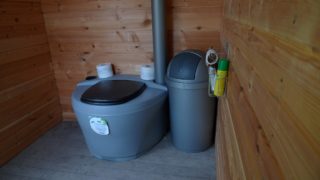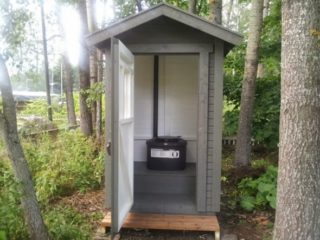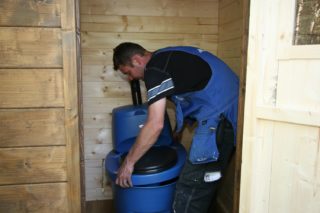One of the most important buildings on any residential or partly residential plot is the toilet. The best choice for a summer residence is a toilet without a cesspool. This design has a number of important advantages over traditional construction (mobility, lightness and ease of construction). Even a novice master can install such a closet, since complex installation and construction work will not be required.
Types of toilets without a cesspool
The first type is peat or composting models. There is a special box near the toilet seat, into which peat is poured. This substance is a catalyst and a kind of "dusting agent" for waste. After filling the peat container, you need to get it out, clean it. You can make a peat toilet yourself or buy it completely ready-made. In finished devices, peat is poured into a container through a special hopper - an opening located under the lid.
The following view is electrical models. The toilet has 2 independent containers: for feces and for liquids. Liquid waste is evaporated, discharged into the sewer or drainage system, solid waste is dried to a powder state using an installed compressor. The device requires constant electrical current to operate smoothly. Some models are equipped with a rechargeable battery.
The third type is chemical (liquid) toilets. The model consists of 2 vertically arranged containers:
- for water;
- for fecal masses.
This is a fairly simple construction. To get started, you need to fill in water, add a special chemical or biological reagent for waste processing. The model has a different storage capacity (from 12 to 24 liters). There are also special valves to facilitate cleaning the containers. An additional convenience is the equipping of toilets with comfortable seats.
The advantages and disadvantages of each type
Among the disadvantages of a peat closet is regular filling with peat and necessarily equipping with a ventilation system.
The next type is electric. Among the advantages of the design:
- maintaining performance at temperatures below 0;
- rare cleaning of waste bins (no more than 3 times a year);
- no expenses for the purchase of reagents;
- the dried waste is very light and easy to dispose of.
Among the disadvantages of the design are volatility and energy consumption, a higher cost, a complicated construction device.
The strengths of chemical toilets are versatility and mobility of use, complete independence from communications, and a loyal pricing policy. Such closets are airtight and hygienic, do not emit a stench. Weak sides:
- the need to purchase reagents (materials to neutralize an unpleasant odor);
- increased frequency of cleaning the container;
- toxicity of recycled waste.
Selecting a place for installation
There are no strict rules and restrictions when choosing a place for such closets, since the waste will not directly contact the environment.Any soil is suitable for the construction of this type of building; long preparatory work is not required. But some nuances still persist.
- It is desirable to comply with the SNiP requirements - 8 m to the existing well and 12 m to residential buildings.
- Distance at least 1 m from the boundaries of the site.
- Convenient access to the toilet (if you plan to clean the containers with a sewer machine).
The recommendations presented are only wishes for execution. Many models of dry closets can be placed directly in the house or in a car-trailer.
Construction and installation
- slate and roofing material;
- tiles or galvanized sheets;
- wood (boards, timber);
- plywood or lining;
- door block;
- auxiliary materials (nails, screws, dowels, clamps).
The following are basic steps with step-by-step instructions. The first stage is the construction of the foundation. This stable base is essential for a longer service life and for increased structural reliability. There are 2 options for performing an action.
- Tape. Dig a trench around the perimeter, cover the bottom with a sand pillow (thickness - 10-20 cm). Next, make a formwork, reinforce with metal rods, secure with steel wire and pour concrete.
- Columnar. It is permissible to use wooden, concrete or metal poles (at the choice of the owner). Such supports will prevent the corner supports from moving.
The next stage is the construction of the frame. You will need a wooden beam with a section of 100x100 mm.
- Antiseptic treatment.
- Manufacturing of a wooden frame.
- Installation and fastening to the foundation with dowels.
Next, vertical racks with ready-made roof beams are attached to the finished base. The roof is covered with slate. A layer of roofing material is placed in front of it for better protection. For the floor, densely laid boards are also used. For external wall cladding, siding or corrugated board is used, for interior - lining.
The roof is recommended to be made at an angle so that precipitation does not accumulate on it. Therefore, the front struts should be 15-20 cm higher than the rear ones.
The final important stage is the installation of the ventilation system. For this purpose, a plastic pipe or corrugated pipe of a small diameter is suitable. The lower end is fixed 5-7 cm from the floor, the upper end is 20 cm above the roof. The pipe is mounted to the back wall of the toilet with clamps. A deflector is put on the top of the pipe - an aerodynamic device for better air draft.
So, a toilet without a cesspool is an excellent choice for summer cottages. Such structures are mobile and easy to operate, their installation does not require complex installation. Closets are divided into types: peat, electric, liquid. Each type has its pluses and minuses. Before choosing a design, it is recommended that you carefully familiarize yourself with all the nuances.












Well, why are you all the time wise and make complex from simple. We have an ordinary plastic toilet. I dry the cut grass, put the filled bucket of hay in the toilet and apply powder after each visit. There is no smell in the toilet and there is order on the site.